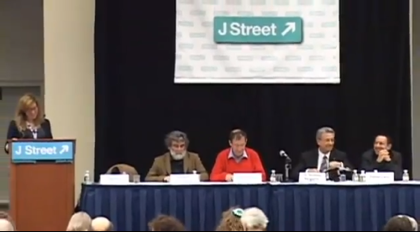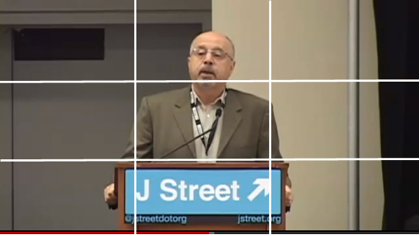Live from J Street, Part 2: Framing Tips for Conference Shooters and Webcasters
Jan Ozer passes on several key tips on framing panels and applying the rule of thirds (and when to break it) gleaned from his recent gig webcasting the national J Street conference on Israeli-Palestinian relations.
This is the second segment in a multipart series on webcasting a conference. As I detailed in the first segment, though I've produced numerous live events and multiple webcasts, I'm totally self-taught, and have done most of my work alone. Recently, after being hired by Brendon Winters of Event Technology Partners to help stream JStreet.org's national convention, I got the chance to work with two of his more experienced associates-accomplished shooter Manrico Zottig, and webcasting expert Bern Rexer-and learned a ton from both. In this segment I'll detail what I learned by watching Manrico shoot the sessions we worked on together.
Framing a Panel
Figure 1 (below) shows the panel that Zottig was in charge of shooting, and I was in charge of streaming. It's a typical panel: a podium on the left where each speaker gave introductory thoughts, and a table for discussion. What struck me when I was watching the production was how precisely Zottig framed his shots, never cutting off critical edges and minimizing problem areas in the scene.

Figure 1. The basic setup for our conference
For example, there's a metal pole peeking out on the right, and the drape doesn't extend to the right as far you'd like. As you'll see, Zottig adjusted his framing to minimize this and other problems.
Basic Rule of Thirds
Figure 2 (below) shows the shot of the speaker at the podium (from a different session) with rule-of-third guides. Stealing from Wikipedia, the rule of thirds "proposes that an image should be imagined as divided into nine equal parts by two equally-spaced horizontal lines and two equally-spaced vertical lines, and that important compositional elements should be placed along these lines or their intersections." The intersections of the lines in the tic-tac-toe-like board are called "saddle points."

Figure 2. Classic rule of thirds positioning for a speaker facing the camera. Well, perhaps a little high.
Typically, when shooting people, the eyes are the most important compositional elements. When the person is facing the camera, as the subjects are in all shots shown here, you place the subject in the middle of the camera with eye level at the top or bottom third. This is your classic anchorman-type video. If the person was facing your left, you'd place their eyes on one of the right saddle points, leaving "look room" or "negative space" on the left. If facing your right, you'd place their eyes on one of the left saddle points.
Related Articles
In this final segment of this series on the JStreet Making History convention webcast, we'll examine one aspect of webcast production that too often gets ignored: monitoring and controlling audio volume, which becomes a complex issue as speakers change, audio techs and shooters adjust their own levels, and the webcaster is left to make sure the signal sent over the web remains audible and consistent.
HP's Z1 is the first all-in-one computer with workstation components and field serviceability. Here, encoding expert Jan Ozer takes a look at how this workstation-class portable PC fared in a live production and webcast environment, with testing emphasis in 3 areas: rendering, streaming encoding, and live encoding.
During a 3-day gig as webcaster for J Street's Making History conference on Israeli-Palestinian relations, Jan Ozer learned a lot about the challenges of streaming events where you don't control critical factors like the set background and lighting. In part 1 of 3 on this project, Jan details the planning process and streaming setup.